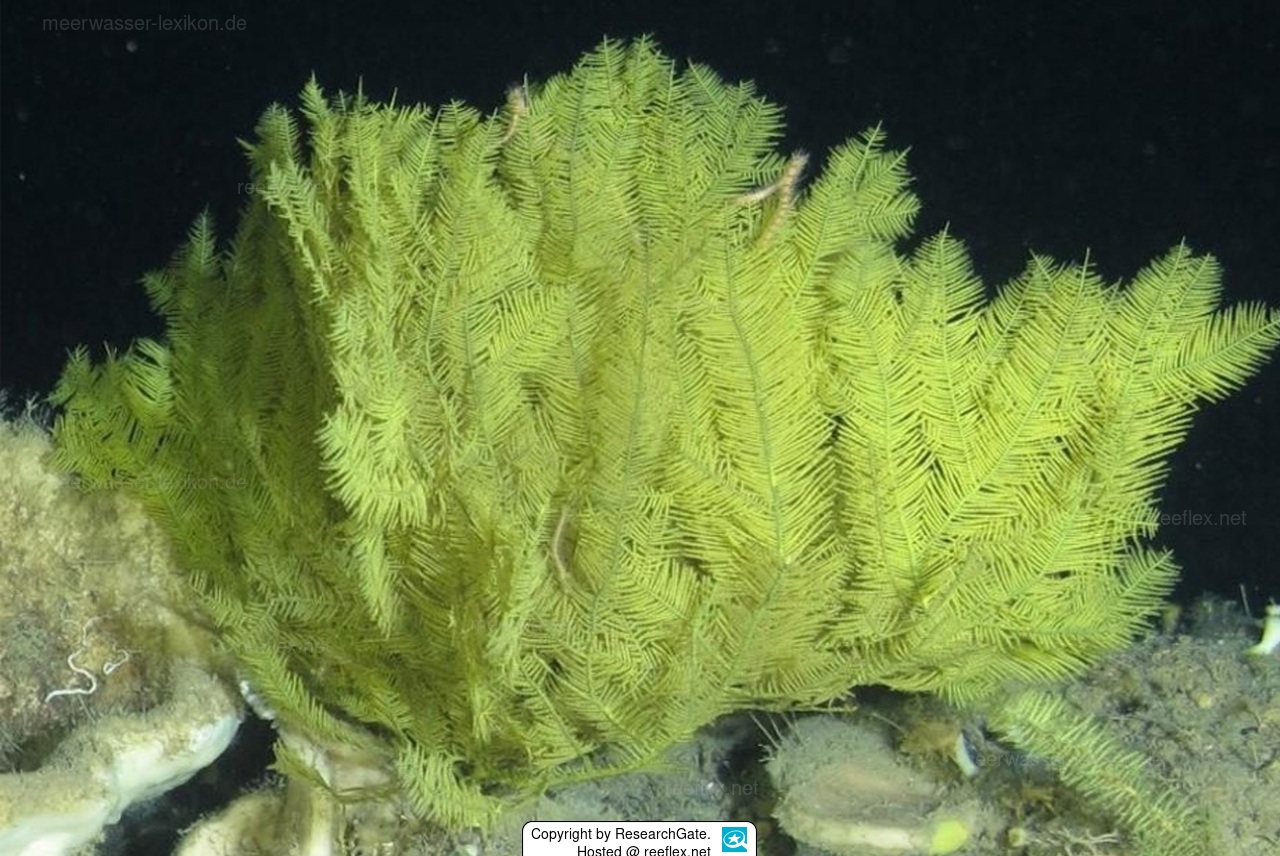Info
Wow, let's hear no more about deep-water corals not being pretty to look at! These wonders of the deeper waters are every bit as colourful as their tropical counterparts!
In 2020, a specimen of black coral collected in Elvers Bank in 2017 was confirmed as a new species. Although the specimen was collected outside the current protected area boundary in Elvers Bank, it is likely that further specimens of this coral will also be found within the protected area boundary.
The holotype (USNM 1517703) of this beautiful coral is a medium-sized complete colony with a height of about 21 cm and a width of 17 cm (see Figures 3A, B and 6A) in the initial description.
The colony is branched to the fifth order, with the branches being planar and neighbouring branches overlapping.
The diameter at the base of the stem directly above the holdfast is 3.7 mm.
Several large first-order branches arise directly above the holdfast, one of which extends to the tip of the colony.
The stem and branches have simple, thread-like leaflets that are up to about 2 cm long and have a diameter of 0.3 mm at the base. The leaflets vary slightly in size from branch to branch and may also be shorter on the lower parts of the branch than on the more distant segments.
Newly emerging leaflets at the tips of the branches gradually increase in size proximally until they reach a uniform length.
The leaflets are arranged in two lateral rows, with the members of each row spaced 1–1.4 mm apart (from the centre of the leaflet at the base to the centre of the base of the adjacent leaflet in the same row), resulting in a total of 16–18 leaflets per cm for both rows.
Most leaflets are distally inclined, but some protrude at nearly right angles to the axis of the stem or branch.
The interior angle formed by the two rows of leaflets is nearly 180°. Individual leaflets occur on the abapylary side of the stem and branches.
Etymology:
The species name ‘hickersonae’ honours Emma L. Hickerson (research coordinator of NOAA's FGBNMS). Since 2005, Emma has generously invited co-authors DMO and MRB, as well as underrepresented minority students from CUNY, to the FGBNMS to study and collect black corals.
These research trips aboard the MV Spree and the RV Manta have led to the discovery of a number of new species of Antipatharia corals.
Scientific reference:
Opresko, Dennis & Goldman, Samantha & Johnson, Raven & Parra, Katherine & Nuttall, Marissa & Schmahl, G.P. & Brugler, Mercer. (2020).
Morphological and molecular characterisation of a new species of black coral from Elvers Bank, north-western Gulf of Mexico (Cnidaria: Anthozoa: Hexacorallia: Antipatharia: Aphanipathidae: Distichopathes).
Journal of the Marine Biological Association of the United Kingdom. 100. 1-8. 10.1017/S002531542000051X.
CC BY 4.0
In 2020, a specimen of black coral collected in Elvers Bank in 2017 was confirmed as a new species. Although the specimen was collected outside the current protected area boundary in Elvers Bank, it is likely that further specimens of this coral will also be found within the protected area boundary.
The holotype (USNM 1517703) of this beautiful coral is a medium-sized complete colony with a height of about 21 cm and a width of 17 cm (see Figures 3A, B and 6A) in the initial description.
The colony is branched to the fifth order, with the branches being planar and neighbouring branches overlapping.
The diameter at the base of the stem directly above the holdfast is 3.7 mm.
Several large first-order branches arise directly above the holdfast, one of which extends to the tip of the colony.
The stem and branches have simple, thread-like leaflets that are up to about 2 cm long and have a diameter of 0.3 mm at the base. The leaflets vary slightly in size from branch to branch and may also be shorter on the lower parts of the branch than on the more distant segments.
Newly emerging leaflets at the tips of the branches gradually increase in size proximally until they reach a uniform length.
The leaflets are arranged in two lateral rows, with the members of each row spaced 1–1.4 mm apart (from the centre of the leaflet at the base to the centre of the base of the adjacent leaflet in the same row), resulting in a total of 16–18 leaflets per cm for both rows.
Most leaflets are distally inclined, but some protrude at nearly right angles to the axis of the stem or branch.
The interior angle formed by the two rows of leaflets is nearly 180°. Individual leaflets occur on the abapylary side of the stem and branches.
Etymology:
The species name ‘hickersonae’ honours Emma L. Hickerson (research coordinator of NOAA's FGBNMS). Since 2005, Emma has generously invited co-authors DMO and MRB, as well as underrepresented minority students from CUNY, to the FGBNMS to study and collect black corals.
These research trips aboard the MV Spree and the RV Manta have led to the discovery of a number of new species of Antipatharia corals.
Scientific reference:
Opresko, Dennis & Goldman, Samantha & Johnson, Raven & Parra, Katherine & Nuttall, Marissa & Schmahl, G.P. & Brugler, Mercer. (2020).
Morphological and molecular characterisation of a new species of black coral from Elvers Bank, north-western Gulf of Mexico (Cnidaria: Anthozoa: Hexacorallia: Antipatharia: Aphanipathidae: Distichopathes).
Journal of the Marine Biological Association of the United Kingdom. 100. 1-8. 10.1017/S002531542000051X.
CC BY 4.0







 ResearchGate
ResearchGate




